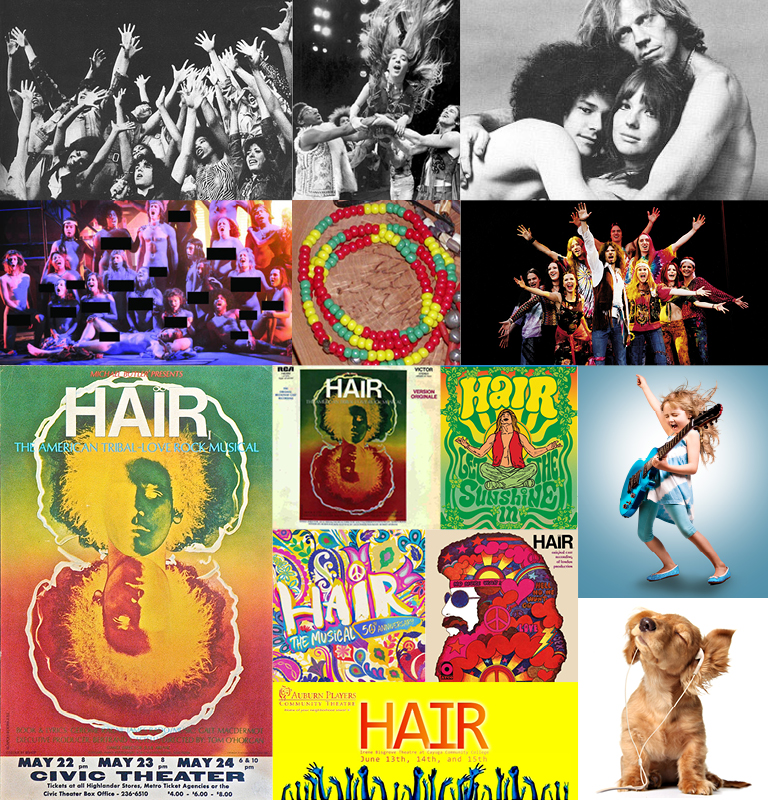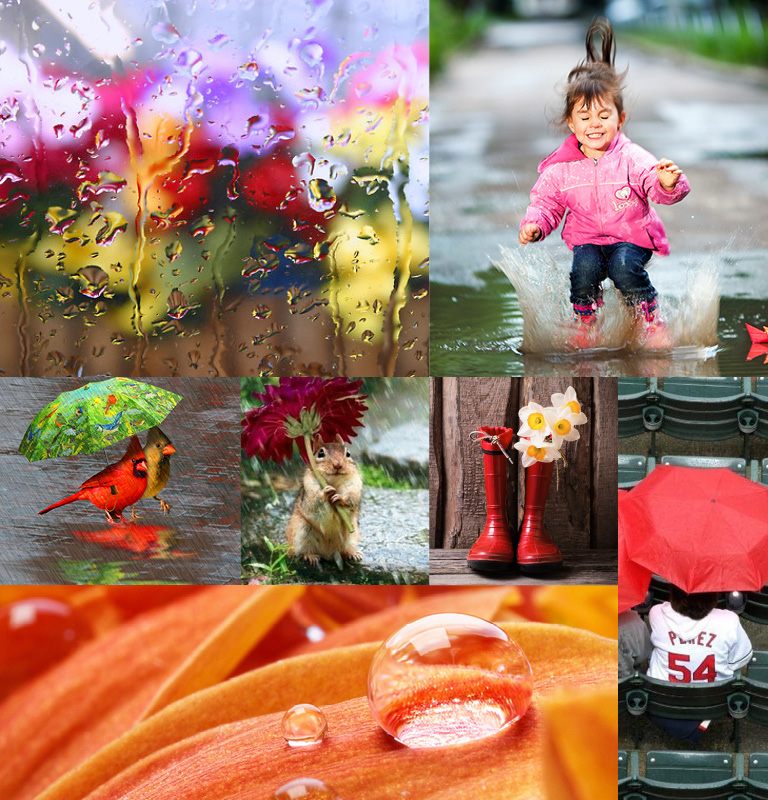Let The Sunshine In

(top row) Some original Hair production photos. Diane Keaton (far right) was in one of the early shows. (2nd row l to r) The Duluth Minnesota News Tribune sensationalized (on page one!) the 10 seconds of nudity at the end of act one with this censored photo and the headline “Does ‘Hair’ cast go all the way?” I’m thinking they sold more papers that day; Love beads; The cast at one of the performances in Germany. (3rd row left) The original show poster (3rd row middle) Four of the album covers of cast recordings (the original in the upper left) and a promotion banner created through the years. (3rd row right) Everyone gets into the act including Lulu, the hairiest of them all at bottom right.
Wow, what a glorious day here in Cleveburgh. After my run this morning, I found myself really enjoying spring in all its glory, watching the sun come up from my office overlooking Lake Erie – birds chirping, trees and flowers blooming and the fresh budding smells of the season. And, like you may often do, I found myself singing out loud that so familiar “sunshine” tune, as I cracked open my window to feel the warmth and rays of the sun. Now, it’s important to keep in mind that I can only sing in my office when no one else is around! It’s hard to describe in words, but fresh air and sunshine just puts me in a great mood as I head off to work and tackle your fun and challenging PIA (Pain In The @%$) Jobs of the day. For this week’s post, I did some digging, too, to learn more about the famous musical that rocked our culture of the day, and personally spoke to me years later (yes, as you know I am follicly challenged). Here is some fun reading about this awesome musical HAIR, a link to the Aquarius/Sunshine soundtrack and few of the other great tunes in the show – and thanks again Wikipedia and history.com.
- In a year marked by as much social and cultural upheaval as 1968, it was understandable that the New York Times review of this controversial musical newly arrived on Broadway describes the show in political terms. “You probably don’t have to be a supporter of Eugene McCarthy to love it,” wrote critic Clive Barnes, “but I wouldn’t give it much chance among the adherents of Governor Reagan.” The show in question was Hair,
- The now-famous “tribal love-rock musical” that introduced the era-defining song “Aquarius” and gave theatergoers a full-frontal glimpse of the burgeoning 60s-counterculture esthetic, premiered this weekend on Broadway almost 50 years ago.
- Hair was not a brand-new show when it opened at the Biltmore Theater. It began its run 40 blocks to the south, in the East Village, as the inaugural production of Joseph Papp’s Public Theater. Despite mediocre reviews, Hair was a big enough hit with audiences during its six-week run to win financial backing for a proposed move to Broadway, exceedingly rare for a musical at the time, and a particularly bold move for a musical with a nontraditional rock and roll score.
- The novelty of the show didn’t stop with its music or references to sex and drugs. Hair also featured a much-talked-about scene at the end of its first act in which the cast appeared completely nude on the dimly lit stage. It turned out that these potentially shocking breaks from Broadway tradition didn’t turn off Broadway audiences at all, as Hair quickly became not just a smash-hit show, but a genuine cultural phenomenon that spawned a million-selling original cast recording and a #1 song on the pop charts for the Fifth Dimension.
- Hair tells the story of the “tribe”, a group of politically active, long-haired hippies of the “Age of Aquarius” living a bohemian life in New York City and fighting against conscription into the Vietnam War. Claude, his good friend Berger, their roommate Sheila and their friends struggle to balance their young lives, loves, and the sexual revolution with their rebellion against the war and their conservative parents and society. Ultimately, Claude must decide whether to resist the draft as his friends have done, or to succumb to the pressures of his parents, and conservative America, to serve in Vietnam, compromising his pacifist principles and risking his life.
- Hair was conceived by actors James Rado and Gerome Ragni. The two met in 1964 when they performed together in the Off-Broadway flop Hang Down Your Head and Die, and they began writing Hair together in late 1964. The main characters were autobiographical, with Rado’s Claude being a pensive romantic and Ragni’s Berger an extrovert. Their close relationship, including its volatility, was reflected in the musical. Rado explained, “We were great friends. It was a passionate kind of relationship that we directed into creativity, into writing, into creating this piece. We put the drama between us on stage.”
- The inspiration for Hair as “a combination of some characters we met in the streets, people we knew and our own imaginations. We knew this group of kids in the East Village who were dropping out and dodging the draft, and there were also lots of articles in the press about how kids were being kicked out of school for growing their hair long”.
- Said Rado, “There was so much excitement in the streets and the parks and the hippie areas, and we thought if we could transmit this excitement to the stage it would be wonderful…. We hung out with them and went to their Be-Ins [and] let our hair grow. “Many cast members (Shelley Plimpton in particular) were recruited right off the street. It was very important historically, and if we hadn’t written it, there’d not be any examples. You could read about it and see film clips, but you’d never experience it. We thought, This is happening in the streets,’ and we wanted to bring it to the stage.”
- The first recording of Hair was made in 1967 featuring the off-Broadway cast. The original Broadway cast recording received a Grammy Award in 1969 for Best Score from an Original Cast Show Album and sold nearly 3 million copies in the U.S. It charted at No. 1 on the Billboard 200, the last Broadway cast album to do so (as of 2016). It stayed at No. 1 for 13 weeks in 1969. The New York Times noted in 2007 that “The cast album of Hair was… a must-have for the middle classes. Its exotic orange-and-green cover art imprinted itself instantly and indelibly on the psyche…. [It] became a pop-rock classic that, like all good pop, has an appeal that transcends particular tastes for genre or period.”
- Forty years after its initial downtown opening, Charles Isherwood, writing for the New York Times, placed Hair in its proper historical context: “For darker, knottier and more richly textured sonic experiences of the times, you turn to the Doors or Bob Dylan or Joni Mitchell or Jimi Hendrix or Janis Joplin. Or all of them. For an escapist dose of the sweet sound of youth brimming with hope that the world is going to change tomorrow, you listen to Hair and Let the Sunshine In.” Listen to Hair and Let the Sunshine In!
Watch & Listen: “Hair” LIVE @ The 2009 Tony Awards HERE
Listen to the original cast version: The Flesh Failures (Let the Sunshine In) HERE
Listen to the 5th Dimension version: Aquarius/Let the Sunshine In HERE
.
.





